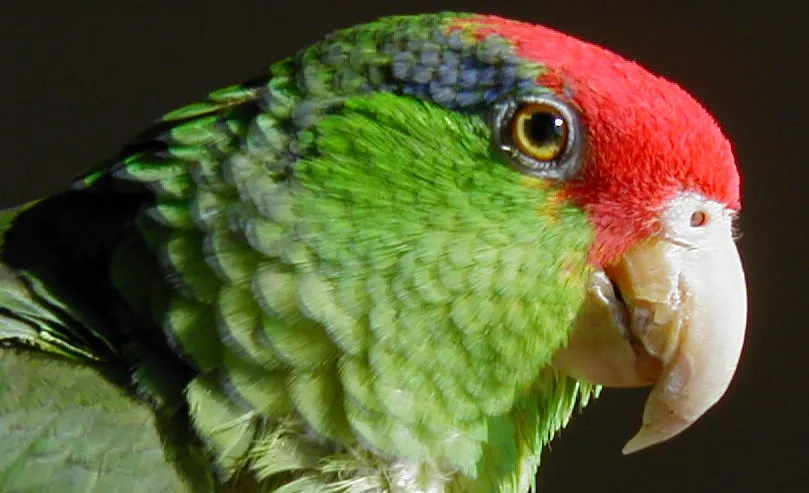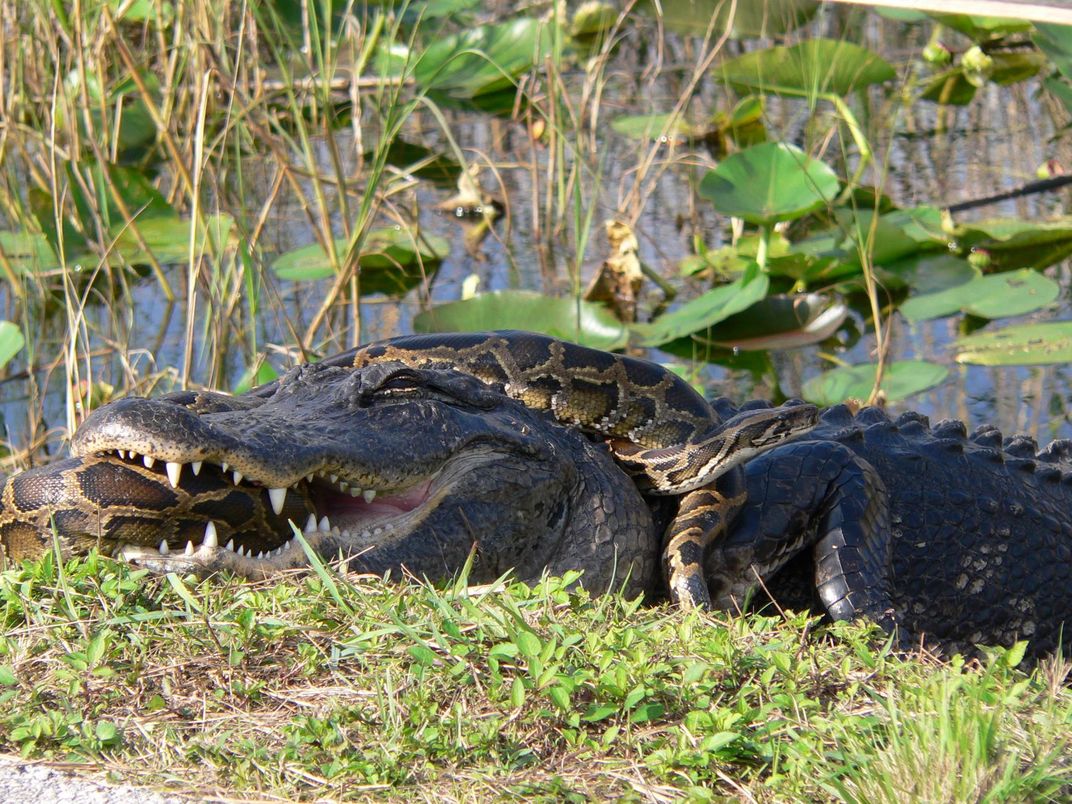To Save Endangered Species, Should We Bring Them Into Our Cities?
Some ecologists believe our best chance to preserve biodiversity is to introduce non-native species to cities—but others warn of unintended consequences
:focal(3599x2399:3600x2400)/https://tf-cmsv2-smithsonianmag-media.s3.amazonaws.com/filer/66/b5/66b5ead9-d2ae-40f3-84c4-3e742cbacb67/fjxjdh.jpg)
The red-crowned parrot is native to eastern Mexico, but if you want to see one in the wild, your best bet is to head to Pasadena, California.
Some estimates count fewer than 2,000 red-crowned parrots in their native habitat, while escapees from the pet trade have settled farther north, where much larger populations are thriving in an unexploited ecological niche. This feral colony might be the only thing preventing the colorful birds from going extinct.
Though the red-crowned parrot was accidentally introduced to the Los Angeles ecosystem, one scientist proposes facilitating such migrations of non-native endangered species on purpose, giving threatened animals a second chance in our own cities.

Brad Shaffer, a conservation biologist at UCLA, says that artificial habitats in cities could provide a perfect opportunity to save critically endangered species. It's virtually guaranteed that something will eventually arrive to claim those habitats, he argues, so why not give them over to the creatures we want to save?
"There are a lot of parrots out there in the world, and some parrot is going to show up,” Shaffer says. “So, wouldn't we rather have a larger fraction of those non-natives be [a species that is] seriously endangered in its home turf? Then at least we're accomplishing something."
Messing With Nature
Introducing non-native species to cities could provide "assurance colonies" of endangered creatures, Shaffer says. If introduced parrots—or reptiles or insects—thrive in their new homes, the world would be less likely to lose valuable biodiversity, and the selected species could also crowd out less desirable invasives. (“Introduced” or “non-native” species don’t naturally occur in a habitat, but they don’t do much harm, while “invasive” species outcompete or eat the local wildlife.)
Still, the idea of bringing non-native animals to new habitats on purpose has many ecologists howling.
"Despite our wisdom and intelligence, it's very difficult to predict which species are going to become invasive," says Adam Smith, an ecologist at the Missouri Botanical Garden.
In 2013, Smith proposed a plan to "chaperone" plant species from their native habitats into botanical gardens to preserve them—similar to how zoos transfer endangered animals from place to place to better manage a species. Gardens would be equipped to protect the fragile seedlings and monitor them to prevent invasive spreading. But Smith has stopped pushing the idea, he says, after becoming concerned that monitoring wouldn’t be enough to prevent invasive species from escaping the gardens.
/https://tf-cmsv2-smithsonianmag-media.s3.amazonaws.com/filer/af/06/af06364b-8c5d-4173-93f0-8f884a0017ae/golddustdaygecko.jpg)
Shaffer, on the other hand, insists that properly vetted non-natives can be managed within cities. "Non-native species in urban environments ... [tend to] rely on people. They rely on us watering lawns, they rely on fruit trees. ... They need us, they need our artificial environments." Accordingly, he says, the chances of non-native creatures escaping into the wild and wreaking havoc on natural ecosystems is low.
Shaffer’s proposal also calls for non-native species to be introduced if and only if there are no native species to occupy a particular ecological niche. Hawaii, for example, has no native geckoes. All eight species arrived with Polynesian settlers over a millennia ago, and they mostly stick to urbanized areas. It wouldn't be unreasonable, Shaffer says, to consider moving in a ninth gecko—one threatened in its native range that could thrive in Hawaii.
"Something's going to get out [to an unoccupied habitat] eventually," says Ursula Heise, a collaborator of Shaffer's who teaches in both UCLA's English department and its Institute of the Environment and Sustainability. "Wouldn't you rather have something that you chose than something that gets out by sheer luck?"
The "Urban Ark"
More than 25,000 plants and animals worldwide are considered endangered or vulnerable, according to the International Union for the Conservation of Nature. And that number, in general, is trending upward. Habitat destruction, hunting and fishing, climate change and pollution are just some of the threats facing the world's biodiversity.
Cities, some scientists say, present the perfect opportunity to save at least some of these critically endangered animals. Heise recently produced a short documentary about the red-crowned parrot that makes the case for Los Angeles as an "urban ark” to save not just that species, but many more.
"Cities are a valuable place to experiment, and they do offer a more controlled environment" to house species, says Jessica Hellmann, director of the Institute of the Environment at the University of Minnesota. "We have greater tolerances for how much artificialness we allow in our urban landscapes."
We freely plant palm trees in Los Angeles, stock fish in city lakes, and cover acres of front lawns with Poa pratensis (better known as Kentucky blue-grass, which is actually native to Europe and Asia). In a survey of plants in urban Los Angeles, only 5 percent of the species were considered native, says Diane Pataki, a biologist who studies urban vegetation at the University of Utah.
To go back to a "native" ecosystem, the city would have to stop irrigating parks and medians. "There's a big price to pay for that,” Pataki says. “There wouldn't be any trees and it would be hotter, and in the late summer, everything would be brown." People say they want to preserve native species, but the lack of trees and dead lawns "are consequences that most people don't want."
So we already design our urban ecosystems—at least in the case of flora. Why not pick and choose fauna as well? Think Burmese roofed turtles, possibly extinct in the wild and down to a few hundred captive individuals, basking in urban reservoirs, or endangered Karner blue butterflies flitting in urban parks and gardens.
Humans don’t seem to worry as much about introducing plants as they do animals—although plants can be just as destructive. On the other hand, Pataki says, plants don't generally eat other species.
Rewilding the City
Moving species from one place to another is not an entirely new idea. Scientists have been discussing proposals for "managed relocation" or "rewilding" for years. The former involves moving a species to a new habitat as its old habitat deteriorates due to climate change; the latter is about restoring extirpated species to restored habitats. (Rewilding can involve anything from replanting native flowers near a cleaned-up river to restoring extinct camels to North America, last seen on this continent 12,000 years ago.)
In 2016, the critically endangered western swamp tortoise made history when scientists moved 12 captive-bred juveniles to two national parks 225 miles south and 80 miles north of its habitat outside of Perth, Australia. It was the first vertebrate deliberately moved because of climate change (shifting rainfall patterns caused its habitats to dry up).
/https://tf-cmsv2-smithsonianmag-media.s3.amazonaws.com/filer/6b/ae/6baeae02-24ef-4423-bf45-886c9858011a/lycaeides_melissa_samuelis_cropped.jpg)
Other species may soon follow the swamp tortoise. Hellmann says that her biggest critique of the strategy is "the inadequacy of the approach.”
“It's hard to imagine we could just pick up everything and move it around and think it was anything other than a small Band-Aid," she says.
Managed relocation, while not without its detractors, is not as drastic as what Shaffer proposes. The swamp tortoise would have eventually moved to follow the rain if urban sprawl hadn't prevented it, and humans just helped it along a path it probably would have taken on its own—but there's no way the Burmese roofed turtle would walk from Myanmar to Los Angeles.
Risk and Reward
Human history is rife with examples of introductions gone wrong.
Two hundred million European starlings terrorize North America, and they trace their lineage back to a single flock released in Central Park in 1890 by a well-meaning bird lover who thought America should have every species of bird mentioned in Shakespeare. In the Everglades, escaped Burmese pythons from the pet trade thrive and wreak havoc on south Florida's native birds and mammals.
The Tree of Heaven—also known by the decisively less poetic name "stinktree"—was brought to the U.S. from China more than 200 years ago as an ornamental, and now it’s taking over 42 states. The powerfully odorous tree doesn't just outcompete other trees, but it also produces a toxin in its leaves that inhibits the growth of other plants. More recently, the stinktree began providing new habitats and food sources for the spotted lanternfly, a crop-devouring invader that the Pennsylvania Department of Agriculture said "could be the most destructive species in 150 years."

And then there are the diseases. Chestnut trees imported from Japan and China brought with them chestnut blight, which drove the American chestnut tree to extinction.
"In a lot of cases, you don't know what [an introduced species] is carrying," says Jamie Reaser, the executive director of the National Invasive Species Council, a body for coordinating federal work on invasive species. "Do we even have an understanding of ... what the implications could be for every other organism that could come into contact with the [Burmese roofed] turtle, the water the turtle lives in, the soil the turtle lives in?"
Shaffer admits there would be risks to introducing new species to cities. But in his view, the tradeoffs are worth it.
"We've got to do better if we plan for [invasive species] and if we use our science than if we don't,” he says. “It won't be perfect, and there will be some [introductions] that go wrong, but we have to do better than just sitting back and waiting."
Underlying the questions of which species to move, and where to move them, is a question of what we consider “nature” in the first place—or in other words, what are we trying to conserve? In the U.S., we tend to think of nature as the untamed wilderness that European settlers discovered upon their arrival, but we now know that that landscape was heavily managed by Native people. Would it not be more “natural” to allow species to move around as they will, joining us in urban environments (or failing to do so) without the hand of humans guiding the outcome?
Shaffer rejects that notion, as does Pataki. "We have a moral and ethical obligation that comes with our unique awareness of how we impact other species," she says. Ecosystems, rather than being simply preserved, may have to be managed.
After all, cities are our habitats, and if we could introduce endangered species without unintended consequences—which is a big if—it could be a boon not just to nature, but to us.
“Cities are for people,” Pataki says. “It’s okay to design a landscape that … doesn’t clean the atmosphere or have some physical impact, but still makes people happy.”
If we've made peace with the idea of planting trees and flowers, is it wrong to do the same with birds and butterflies?